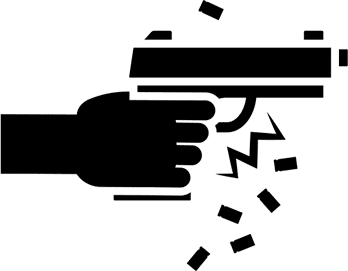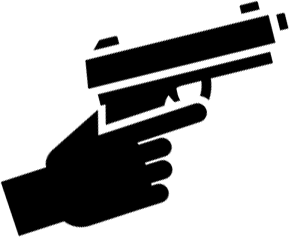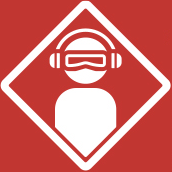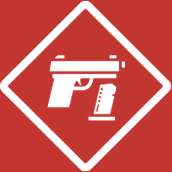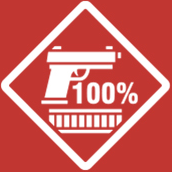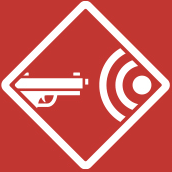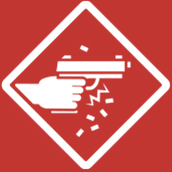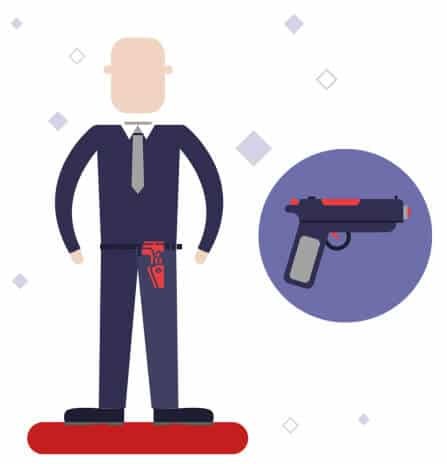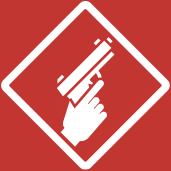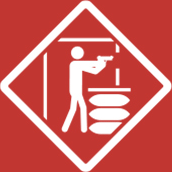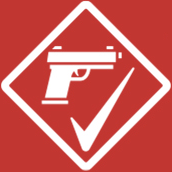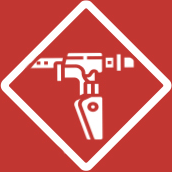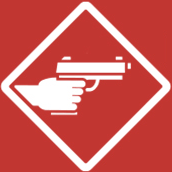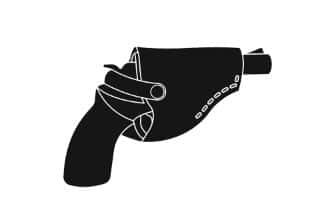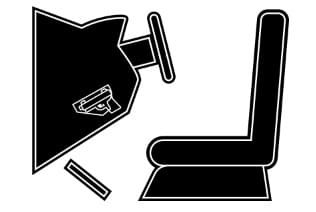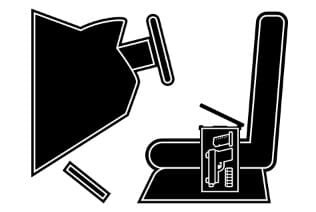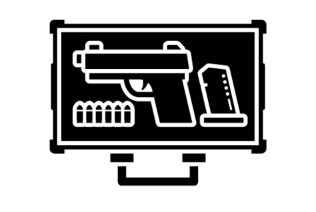If you’re a new gun owner or an experienced gun owner who wants to help newbies learn the proper ins and outs of firearm safety, this quick and easy guide is here to help you.
Table of Contents
The rate of accidental firearm injuries or fatalities caused by unintentional discharge of a loaded gun is alarming. In a study by Dr. Shilpa J. Patel and her team, it was discovered that as many as 63 percent of firearm injuries were defined as unintentional. What’s more, the most common victims of such injuries were children and adolescents from the ages 7 to 21 years old.
Another researcher, Dr. Kiesha Fraser Doh, has likewise observed that most children, regardless of whether they belonged to gun-owning or non-gun-owning households, were unable to tell the difference between toy guns and real ones.
Proper firearm-safety procedures are often made out to be an ineffective solution to unintentional firearm casualties. This has prompted many lawmakers to suggest very stringent measures that compromise individual rights to gun ownership without really solving the issue. In fact, proper and rigorous firearm safety training for gun owners and an added awareness are more than enough to solve the dilemma.
Chapter 1: Gun-Safety Rules
There are four gun-safety rules that have become something of a standard in the world of firearms. These are largely attributed to one Jeff Cooper, a Marine Corps officer and combat veteran of the Second World War and the Korean War. While these four rules are by no means comprehensive, they contain the essence of what gun safety aims to ingrain in every firearms handler.
Rule 1: Treat Every Gun as If It Were Loaded
Most cases of unintentional discharge or accidental injuries result from the presumption that a firearm is clear (i.e., empty). Ascertaining whether or not a gun is clear is in itself a risky endeavor, so play it extra safe by treating every gun that you handle as if it were loaded.
Even if you are perfectly sure that a gun isn’t loaded, treat it like it still is. This leaves no room for error and any potential accidents that may arise when you find out (often too late) that it may, in fact, actually be loaded!
Rule 2: Never Aim a Gun at Anything You Don’t Intend to Shoot
Since you can’t ever really be 100 percent sure if a gun is clear, never point a gun at anything you don’t want to shoot. Never play at pointing a presumably empty gun anywhere, and most especially, never point a gun at a person, even if you know the gun is unloaded. Not only does it still pose a risk to yourself or the other person, but the act is also considered a criminal offense called brandishing. That can land you in prison.
Rule 3: Keep Your Finger off the Trigger until You Are Ready to Shoot
Trigger discipline is of paramount importance when you’re handling a loaded firearm. Some models can have hair triggers, which can discharge at the slightest pressure, and carelessly leaving your finger on the trigger while brandishing a firearm can end badly.
Trigger discipline should also extend to clear firearms, most especially during routine cleanings. You should make it a habit to put your finger on the trigger only once you have locked on a target and are sure that you want to fire.
Rule 4: Be Sure of Your Target before Firing
The true mark of an experienced firearms handler is in their capacity to gauge whether or not it is safe to shoot their intended target. This involves a careful scrutiny of your environment and the nature of your target.
If you’re firing at a moving target, you have to make sure nothing is behind it or in front of it, which may take on collateral damage. A stationary target will likewise involve a thorough consideration of whatever is behind and around it to avoid mishaps like ricocheting bullets. If you aren’t sure that you’re going to hit your target with the utmost accuracy, take stock, and do not fire.
These four basic gun-safety laws cover only the surface of proper gun handling and ownership. However, if they’re consistently applied, they will ensure you avoid any possible accidents from occurring whenever you’re handling a firearm.
Chapter 2: Other Gun-Safety Rules
Firearm Safety on the Firing Range
-
Wear protective gear. Whenever you’re in the firing range, make sure you wear protective gear. Eye and ear protection are mandatory.
-
Keep guns unloaded in a “cold” range. To ensure safety, guns in a cold range must always be checked by others that their firearms are unloaded. In a cold range, firearms are placed in the shooting bench. They are completely unloaded, with their actions open, and should be left that way unhandled.
-
Load only in a “hot” range. If a cold range has been declared hot, that is the go signal to load, aim, and fire guns. Under no circumstances must you load, aim, and fire unless the range is declared hot. Only shooters are allowed in a hot range.
-
Be aware of your surroundings. Always ensure that nobody is crossing the range or is moving from a hot range to a cold range before you take aim and fire. Always double-check that no one is downrange or that you or anyone else will not mindlessly step into a hot range.
-
Aim and shoot only at designated targets. Make sure that you only aim for proper targets within a range. Aiming elsewhere or at items that are not set at the appropriate height for a target may result in rounds escaping the range and in accidents.
-
Practice proper trigger discipline. Keep your finger off the trigger while in the process of aiming, and pull the trigger only when you’re sure that you’re ready to shoot the target.
Gun Safety for Open and Concealed Carry
-
Choose your type of carrying form. Will you carry your gun openly or as a concealed weapon? Choosing a type of carrying form beforehand (in accordance to personal preferences, local laws, or both) will help in deciding how best to outfit yourself for carrying your gun.
-
Pick the right holster for your gun. A gun holster is specifically designed to allow for a secure, snug, and tamperproof way to carry a gun. There are variants available for both open and concealed carry, and they can be made from an assortment of different materials, although leather has traditionally been the go-to choice.
Choose a holster that fits your gun like a glove and is of solid, preferably seamless, construction. It would be ideal to choose one that is custom-made to your specific gun’s model.
-
Invest in a proper gun belt. A proper gun belt isn’t just a fashion statement—it ensures that your holstered weapon is secure and won’t droop or sag regardless of its weight. It also guarantees smoother and more reliable drawstrokes for faster response. It also helps to distribute weight around your waist more evenly, allowing you to carry additional mags and associated tools and accessories on top of your holstered firearm comfortably.
-
Learn the safety options for your chosen gun model. Almost all guns on the market today—with the exception of black-powder Old West–style firearms—always have one, if not several, mechanical safety features installed. Familiarize yourself with them, and decide whether or not to engage these safety features while carrying.
-
Learn safe carrying procedures for long-range firearms. Learn how to properly carry long-range firearms, especially if you wish to participate in or regularly participate in hunting excursions and recreational shooting. Familiarize yourself with sling carrying, trail carrying, cradle carrying, and ready-carrying modes. Learn about their respective benefits and drawbacks too.
-
Practice standard safety protocols. As with anything involving firearms, practice the standard four-step safety protocol when carrying any firearm, regardless of caliber.
Gun Safety Rules When Drawing Your Firearm
Here are some safety tips you should practice repeatedly until they become almost second nature each time you draw your firearm:
-
Practice a firm, ready grip. Whether you’re drawing your gun quickly or slowly, it is always important to clasp the grip firmly, as if you were preparing to fire.
Do not draw your firearm with a limp grip, assuming that you can tighten your grip or stabilize the gun in your hand after drawing. Chances are you won’t be able to do so. Limp grips are what often cause guns to accidentally slip from a shooter’s hands and can pose a great risk.
-
Trigger discipline applies at all times. Never forget trigger discipline when drawing your firearm. Always keep your finger away from the trigger until you’re certain about shooting your intended target.
-
Take note of your trigger safety. Almost all handguns today have a physical trigger safety option. This usually looks like a small, raised section on the front of the trigger. Many handgun models also have manual safeties near the grip. Know if your trigger is set to Safe or Fire when storing and drawing your weapon. Know if your trigger is set to Safe or Fire. Adjust the setting per your needs.
-
Invest in a high-quality holster. Not all gun holsters are made the same. Make sure you invest in a holster that ensures proper support, smooth drawing, and a secure hold. A flashy holster doesn’t necessarily mean it’s reliable.
Kydex holsters and high-quality molded-leather holsters are two of the most popular choices. Make sure your chosen holster is suited for the carrying method you prefer (concealed or open carry) and that it’s specifically fitted for your gun’s model.
-
Practice drawing your firearm. Practice drawing your gun until you can do it effortlessly and perfectly. All it takes is one single mishap to cause a fatal accident, so getting your draw flawlessly perfect, especially in high-stress situations, will make all the difference.
Firearm Safety While on the Road
- Choose a preferred carrying method. There are four basic firearm-carry methods while on the road: concealed vehicle carry, vehicle rapid deployment, accessible vehicle transport, and inaccessible vehicle transport. Choose the best one that suits your needs.
-
Concealed carry. For concealed-carry options, you may want to opt for a concealed shoulder holster instead of a regular waist-strapped one. That will make drawing your firearm easier, if ever there’s a need for it.Alternatively, you can also opt for clip-on holsters that can easily be removed and reattached. Of course, factors like gun size will ultimately decide if this option is possible.
-
Rapid-deployment and ready-armed options. If lightning-fast access to your firearm is a necessity in your line of work, use a specialized vehicle holster. The holster is mounted on the steering column, right below the dash, or anywhere in the interior of your car. This allows you to quickly draw your gun and assume a firing position.
-
Concealed accessible transport. If you frequently travel with your kids or loved ones and don’t want them to have unimpeded access to a loaded gun, you may want to invest in a mountable small gun safe. That will keep your firearm out of reach from prying hands but just near enough for those times when you really need it.
-
Concealed inaccessible transport. Some states and countries have specific rules that allow only the transportation of firearms in safe, sealed containers. This option is also ideal if you want to keep your firearms safe from potential theft.
Gun safes and hard cases with molded foam lining to prevent shocks are all excellent options for concealed inaccessible transportation of firearms. They usually come with a heavy-duty cable affixed to the vehicle to prevent theft.
Rules of Gun Safety during Cleaning, Maintenance, and Modification
- Checking the firearm to ensure it’s not loaded
- Removing any ammunition, which may still be chambered, and keeping away magazines and ammunition away from the area where you intend to clean or modify your gun
- Disassembling your gun in an organized manner to ensure all parts are accounted for during disassembly and reassembly
Whether you’re cleaning, disassembling, or modifying a gun, always implement the following safety protocols:
-
Always check your gun if it is or isn’t loaded. If loaded, safely unload the chambered round in a separate room from your cleaning area. Before moving into your designated cleaning area, check again to guarantee that the gun isn’t loaded.
-
Ammo is off-limits. Keep mags, loose bullets, and ammunition boxes away from your cleaning area. It is best if you have your ammo stored in a separate area or, if the former option is not possible, in a locked box.
-
Handle an unloaded gun as though it were loaded. Never point the muzzle at anything, most especially other people or yourself. Only point a gun’s muzzle toward you if it has been completely stripped (disassembled) and the slide is separated from the gun barrel.
-
Have a large work space. It is always a better idea to clean, disassemble, or modify a gun on a large work table, not on a cramped one.
-
Wear safety gear. Wear proper safety goggles to prevent any accidental eye injuries during cleaning, disassembly, or modification.
-
Keep all your tools within arm’s reach. Everything you need for whatever job should be easily accessible and arranged in a well-organized manner.
-
Work with absolutely zero distractions. Never casually watch TV while stripping, reassembling, or modifying your firearm. Music and the presence of other people within the room are also discouraged.
-
Double-check your firearm after reassembly. This is to ensure that all parts are accounted for and that everything is in proper, functioning order.
-
Modify only in accordance with the model. If you want to modify a gun, make sure anything that you add (e.g., improved sights, new grips, accurizing, or sporterizing firearms) is always done within the boundaries of the gun’s specific make and capacity.
-
Never attempt repairs on your own. This is pretty self-explanatory. If your gun is damaged, leave it in the care of an expert gunsmith. Never attempt to repair it yourself using shoddy methods.
Chapter 3: Storing Guns and Ammunition Properly
Guns and ammo that are unused must always be stored in a secure area away from the reach of children and other adults.
Why Is Proper Gun Storage So Important?
A regular hidden safe will likewise suffice if you’re unable to invest in more high-end models. The key is to ensure that your guns and ammo are kept secure and that any potential theft, tampering, or access is prevented outright.
Aside from these simple tips, here are additional storage rules you should know:
-
Never store loaded firearms. Always unload your firearms if you are storing them for prolonged periods. Double-check if a gun is cleared before you store it.
-
Keep ammo and firearms stored separately. As an additional safety protocol, always keep your guns stowed away in a separate place from your ammo, so if ever either is compromised, neither can be used.
-
Clean and prime firearms prior to storage. This is important especially if you intend to store a gun for a long time as this prevents the oxidation of gun parts during storage.
-
Store ammo in a cool, dry place. Ammunition will remain usable for decades, if not centuries, if stored in a cool, dry place away from sunlight and moisture.
-
Properly label your storage containers. Always indicate the type, caliber, and number of rounds you have stored, as well as its date of purchase. Similarly, label the storage containers where you stow your firearms. Organization is key to easier access during times when you need your gun the most.
Chapter 4: Who Should Never Be Allowed to Use, Handle, or Be Near Guns?
Any experienced gun owner will tell you that there are people who should never be allowed to use guns, handle them casually, or even so much as go near guns. Here are two kinds of people you should look out for:


Chapter 5: A Quick Guide to Gun Ownership and Children
Talking to Your Children about the Importance of Gun Safety
Kids from the ages of six to nine are undeniably smart, but adults rarely give them enough credit when it comes to exactly how smart they are. If you’re a gun owner who has children, talk to them about gun-safety rules as soon as they’re able to comprehend most simple to moderately complex sentences.
Introducing them early on to the concept of gun safety will help ingrain the practice in their day-to-day habits sooner. This will equip them with the necessary knowledge to use accordingly when presented with the scenario.
Ensuring gun safety is a two-way street, and you shouldn’t just teach your children what to do and how to act. You also have to avoid any possibility of accidents or worst-case scenarios as much as possible.
Try to implement these step-by-step, easy-to-understand guidelines on what to do in the following situations:
Guns at Home
-
Store your firearms in a gun safe if not in use.
-
Always store your firearms unloaded.
-
Store ammunition and firearms in separate safes, preferably in different locations in your house.
-
Regularly check your gun safes or storage areas for signs of tampering.
-
If you see a gun (or what may possibly be a toy gun) lying around in the house—on a table, a desk, a chair, or anywhere at all—do not pick it up.
-
Leave the area where you found it.
-
Look for a trusted adult, and tell them about it immediately.
Gun Owners around the Neighborhood
-
Check with the other adults prior to a visit. Meet them first, and have a little talk about their own methods of gun safety. You may want to ask them to keep their firearms stowed away, out of sight and out of mind, until after the kids are done with their playdates or sleepover.
-
Suggest alternative venues. If the parents are unable to comply for whatever reason, try to suggest alternative venues, like your house, a public playground, or somewhere else safe and away from firearms.
-
If you see a gun (or what may possibly be a toy gun) lying around in the house—on a table, a desk, a chair, or anywhere at all—do not pick it up.
-
Leave the area where you found it.
-
Look for a trusted adult, and tell them about it immediately.
-
If an adult or teenager shows you a firearm, politely decline to see it. Walk away cautiously but calmly, and tell an adult about it immediately.
Knowing the Difference between Toy Guns and Real Guns
-
Teach your child the difference. Let your child know the difference between a toy gun and a real gun. It may help if you point out identifying markers, like weight or color.
-
Even toys should be treated as real. Teach your child gun-safety rules and trigger discipline even with their water guns, Nerf guns, and rubber-bullet guns. This will help prevent accidents and minor injuries from occurring and make gun safety part of an early constructive-safety habit.
-
Make it clear that air guns, BB guns, and paintball guns are not toys. While they’re not “real” guns, they can still cause serious or even fatal injuries. The rules of firearm safety still apply.
-
Treat toy guns as if they were real. Never point your toy gun at someone’s eyes or face. Never turn your toy gun toward yourself and attempt to fire it. Never point your toy gun at animals or public and private property.
-
Play with toy guns only in wide-open spaces. Never play with your toy guns in cramped spaces.
-
If you play with crowds, make sure your gun is not directly pointed at anybody. With the exception of soft-foam Nerf guns and water guns, never point any other type of toy gun at anybody. Do not fire at anybody or anything at will.
Conclusion
Keeping yourself and your loved ones safe from accidents brought about by improper gun handling isn’t all that difficult if you religiously follow basic gun-safety rules. Always remember, whenever you’re handling firearms, you can never be too sure about their safety. In that case, always exercise caution and prudence every step of the way.
https://www.gunsweek.com/en/technics/articles/4-rules-gun-safety
https://www.americanrifleman.org/articles/2011/5/18/jeff-cooper-father-of-modern-pistol-shooting/
https://www.hunter-ed.com/michigan/studyGuide/Firearm-Safety-at-the-Shooting-Range/201023_700042878/
Safe or Not to Safe? Which Mechanical Gun Safety is Right for Concealed Carry?
https://www.nrafamily.org/articles/2019/9/23/manual-safeties-on-carry-guns-pro-vs-con/
https://aliengearholsters.com/blog/handgun-safety-for-concealed-carry/
https://www.usconcealedcarry.com/blog/tips-for-drawing-your-concealed-gun/
https://www.nrafamily.org/articles/2018/3/22/driving-with-guns-how-to/
https://www.nraila.org/articles/20150101/guide-to-the-interstate-transportation
https://www.usacarry.com/6-rules-follow-cleaning-guns/
https://www.bbcleaningservice.com/gun-cleaning-and-safety.html
https://www.nrafamily.org/articles/2018/1/14/how-to-clean-your-gun/
https://www.gunsweek.com/en/technics/articles/4-rules-gun-safety
https://www.usconcealedcarry.com/blog/how-to-properly-store-ammo/
https://gunsafeguy.org/different-types-of-gun-safes/https://www.nrafamily.org/articles/2019/11/5/6-ways-to-safely-store-your-firearms/
One Last Tip
If there’s anyone that knows the AR-15 platform, it’s the US military. As a special offer for our readers, you can get the Official US Army Manual for AR-15/M4/M16 right now – for free. Click here to snag a copy.


